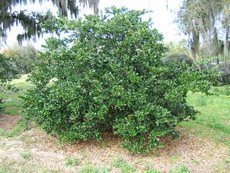Ligustrum japonicum (Ligustrum)

*Click on picture for more images of this species.
- USDA Hardiness Zone: 7B - 10A
- Mature Height: 8 to 15 ft
- Mature Spread: 15 to 25 ft
- Growth Rate: Moderate
- Availability: Available anywhere as a shrub
- Drought Tolerance: High
- Salt Tolerance: Moderate to high
- Light Requirements: Full sun to partial sun
- Native Origin: Not native to North America. Invasive potential has not been assessed.
- Soil Drainage: Needs a well-drained site.
- Foliage: Evergreen tree with no showy fall color.
- Flowers: White, showy flowers in the spring and summer.
- Pests: Free of serious pests and diseases, but thrips and mites can discolor the foliage. Soil nematodes can cause plant decline.
Description: Although often used as a shrub or hedge, Ligustrum works well when allowed to grow into a small tree. Its curved multiple trunks and dark green canopy create an interesting architectural focus, 8 to 12 feet tall and often considerably wider, for the landscape. Old specimens can grow to 25 feet across. The glossy evergreen leaves are abundantly produced on the upright, spreading branches. The small, white, malodorous flowers appear in terminal panicles during spring in the south and in the summer in northern climes. The blooms are followed by abundant blue-black berries which persist most of the year. The berries are popular with birds and the dispersed seeds occasionally germinate where they fall but this is usually not a nuisance.
Although tolerant of tight clipping, Ligustrum is quite attractive when allowed to retain its natural multi-stemmed form, making it ideal for use in shrubbery borders and other informal settings. It makes a nice specimen in any landscape where a small dark tree is needed. Planted close together on about 10 to 15-foot centers, Ligustrum will form a canopy over a pedestrian walkway but will not grow tall or wide enough for canopy closure over a street or parking lot. The tree looks best in a landscape setting with a low groundcover planted around its base.
Ligustrum grows in full sun or partial shade and is tolerant of a wide range of soil types, including calcarious clay as long as water is not allowed to stand in the root zone. Plants grow quickly while young but slow with age. Although it can withstand drought, Ligustrum works best with some protection from direct salt spray. If you decide to use this plant as a clipped hedge, be sure that the top is kept narrower than the bottom to provide light to the lower branches. This will help ensure the plant will remain full to the ground.
Gainesville Observations: Trees are height challenged which means it is a good tree for planting near power lines. Plants are normally wider than tall making them suited for planting along streets provided they are pruned to discourage the spreading habit.. Good nitrogen nutrition is needed to prevent leaf spot from defoliating parts of the canopy. Trees can be trained into a standard with multiple trunks emerging from a 5 to 7 foot tall single trunk.

